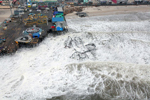
Bush fire in Madagascar. Photo by: Rhett A. Butler.
Scientists currently detect fires around the world using moderate resolution satellite imagery, however a new study in the Journal of Geophysical Research finds that this tool misses many of the world’s smaller fires, which add up.
“Accounting for small fires increased total burned area by approximately by 35 percent, from 345 million hectares/year to 464 million hectares/year,” the scientists write. They employed satellite thermal imaging to catch fires and burn scars that normal satellite images miss.
The researchers found that while small fires did not overwhelm fire estimates in boreal forests or the savannas of Africa and Australia, they markedly added to estimates in tropical forest regions. Just be incorporating small fires, fire estimates estimates jumped 90 percent in Southeast Asia, 143 percent in Central America, and 157 percent in Equatorial Asia. In the U.S., the land area burned by fire jumped 75 percent when small conflagrations were incorporated.
More fires also means more greenhouse gas emitted into the atmosphere and other pollutants. For example, the scientists found that the small fires raised current carbon estimates related to fires by 35 percent, adding 0.6 petagrams of carbon annually.
CITATION: Randerson, J.T., Y. Chen, G.R. van der Werf, B.M. Rogers, and D.C. Morton. How important are small fires for global burned area and biomass burning emissions? Journal of Geophysical Research. 2012.
Related articles
It’s not just Sandy: U.S. hit by record droughts, fires, and heatwaves in 2012

(11/05/2012) As the devastation wrought by Hurricane Sandy—killing over 100 people and producing upwards of $50 billion in damage along the U.S. East Coast—has reignited a long-dormant conversation on climate change in the media, it’s important to note that this is not the only weird and wild weather the U.S. has seen this year. In fact, 2012 has been a year of record-breaking weather across the U.S.: the worst drought in decades, unprecedented heatwaves, and monster forest fires. While climatologists have long stated that it is not yet possible to blame a single extreme weather event on climate change, research is showing that rising temperatures are very likely increasing the chances of extreme weather events and worsening them when they occur.
Climate change causing forest die-off globally

(09/09/2012) Already facing an onslaught of threats from logging and conversion for agriculture, forests worldwide are increasingly impacted by the effects of climate change, including drought, heightened fire risk, and disease, putting the ecological services they afford in jeopardy, warns a new paper published in the journal Nature Climate Change.
Pictures of the day: NASA captures stunning images of U.S. wildfires at night
(08/21/2012) NASA is now able to capture satellite images of wildfires—at night. Using the The Suomi National Polar-orbiting Partnership satellite (S-NPP), which has instruments that are particularly sensitive to light, NASA was able to take images of fires burning nocturnally across the American West in what has been a record year, to date, for fires in the country.